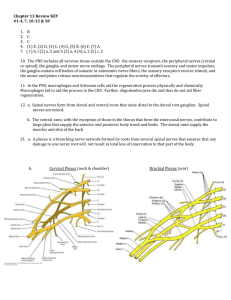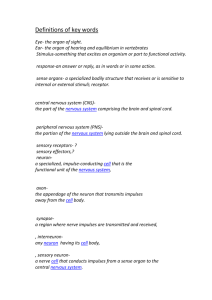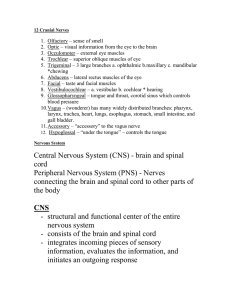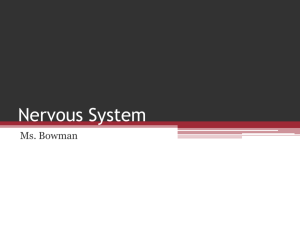Nervous System
advertisement
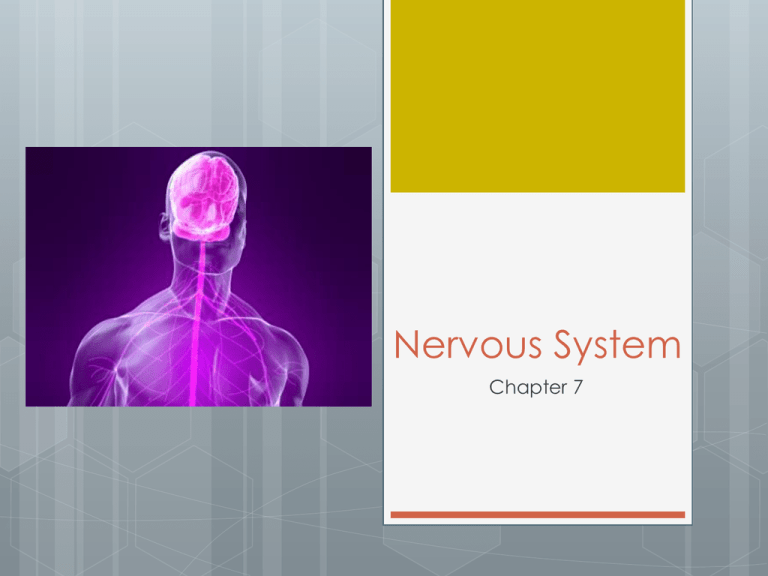
Nervous System Chapter 7 Three Basic Functions: Sensory Input Integration Uses millions of sensory receptors to monitor changes occurring both inside and outside the body…these changes are called stimuli and the gathered information is called sensory input Processes and interprets the sensory input and makes decisions about what should be done at each moment…a process called integration Motor Output Effects a response by activating muscles or glandes (effectors) through motor output Organization of Nervous System: Structural Structures Functional Activities Structural Organization: Includes all nervous system organs 2 subdivisions: Central Nervous System (CNS) Peripheral Nervous System (PNS) Central Nervous System (CNS): Consists of the brain and spinal cord Peripheral Nervous System (PNS): Consists mainly of nerves that extend from the brain and spinal cord Spinal nerves: carry impulses to and from the spinal cord (31 pairs) Cranial nerves: carry impulses to and from the brain (12 pairs) These are the communication lines…linking all parts of the body by carrying impulses from sensory receptors to the CNS and from the CNS to appropriate glands/muscles Cranial Nerves: Listed on pages 250-251 and picture on page 252 12 pairs Serve the head and neck Most are mixed nerves (send impulses both ways…to and from CNS) Only 1 pair-the vagus nerve-extends to the thoracic and abdominal cavities Giraffe Vagus Nerve Dissection Spinal Nerves: Listed on page 255 31 pairs of human spinal nerves are formed by the combination of the ventral and dorsal roots of the spinal cord Each spinal nerve is only about ½ inch long and almost immediately after being formed divides into dorsal and ventral “rami” The rami contain both motor and sensory fibers…thus damage to a spinal nerve or its “rami” results in loss of sensation and paralysis of area of body served Smaller dorsal rami serve the skin and muscles of the posterior body trunk Ventral rami of spinal nerves T1-T12 supply the muscles between the ribs and skin and muscles of the anterior and lateral trunk The ventral rami of all other spinal nerves form the complex networks or nerves called plexuses, which serves the motor and sensory needs of the limbs. Functional Classification: Concerns only PNS structures Divides them into 2 principal subdivisions Sensory (or afferent) division Motor (or efferent) division Functional Subdivisions: Sensory (Afferent): Consists of nerve fibers that convey impulses to the CNS from sensory receptors Motor (Efferent): Carry impulses from the CNS to effector organs, muscles, and glands These impulses activate muscles and glands…they “effect” a motor response Has 2 subdivisions… 2 subdivisions of Motor division: Somatic Nervous System Allows us to consciously, or voluntarily, control our skeletal muscles Often referred to as “voluntary nervous system” Autonomic Nervous System Regulates events that are automatic or involuntary such as the activity of smooth and cardiac muscles and glands Referred to as “involuntary nervous system” Has 2 parts: Sympathetic & Parasympathetic: Bring about opposite effects…one stimulates while one inhibits Nervous Tissue: Structure & Function Nervous tissue is made up of just 2 types of cells…supporting cells and neurons You should remember neurons from the tissue chapter….probably easiest slide to ID! “Neuroglia” (supporting cells) Neuroglia literally means “nerve glue” 6 types: 1. 2. 3. 4. 5. 6. Astrocytes Microglia Ependymal cells Oligodendrocytes Schwann cells Satellite cells Neurons (nerve cells) Highly specialized to transmit messages (nerve impulses) from one part of the body to another Neurons can differ structurally, but have many common features like the cell body (that includes the nucleus and is metabolic center of cell)and one or more processes (or fibers)… Processes: Vary in length from microscopic to 3 or 4 feet…longest ones in humans reach from lumbar region of the spine to the great toe! Processes that convey incoming messages toward the cell body are dendrites (dendr=tree) Processes that generate nerve impulses and conduct them away from the cell body are axons (a&a) Neurons may have hundreds of the branching dendrites, depending of the neuron types, but each neuron has only one axon…all axons branch profusely at their terminal end…forming hundreds to thousands of axon terminals! Axons continued…. Axon terminals contain hundreds of tiny vesicles, or membranous sacs that contain chemicals called neurotransmitters As said earlier, axons transmit nerve impulses away from the cell body…when these impulses reach the axon terminals, they stimulate the release of neurotransmitters into extracellular space Each axon terminal is separated from the next neuron y a tiny gap called the synapse Although they are close, neurons never actually touch other neurons! More Neuron Anatomy: Myelin: Schwann cells: Whitish, fatty material that covers long nerve fibers Protects and insulates the fibers and increases the transmission rate of nerve impulses Specialized supporting cells that wrap themselves tightly around the axon jelly-roll fashion When the wrapping process is done, a tight coil of wrapped membranes, the myelin sheath, encloses the axon Nodes of Ranvier: Since the myelin sheath is formed by many individual Schwann cells, it has gaps or indentations, called nodes of Ranvier at regular internals Nerve Impulses: 2 major functions: 1. irritability The ability to respond to a stimulus and convert it into a nerve impulse 2. conductivity The ability to transmit the impulse to other neurons, muscles or glands. *Figure 7.9, pg.232 describes how nerve impulses work in a step by step manner. Here are some videos: Nerve Impulse Animation Animation: Transmission Across a Synapse Nerve impulse Animation - YouTube Reflexes Rapid, predictable, and involuntary responses to stimuli Like one way streets-once it begins, always goes in the same direction Occur over neural pathways called reflex arcs Involve both CNS and PNS Types of Reflexes: Somatic All reflexes that stimulate skeletal system Ex: When you pull your hand away from hot object Autonomic Regulate activity of smooth muscles, heart, and glands Regulate digestion, elimination, blood pressure, and sweating Ex: Changes in size of pupil Reflex Arcs 5 Elements: 1. 2. 3. 4. 5. Receptor Effector organ Sensory neuron Integration center Motor neuron Brain Anatomy: 4 1. 2. 3. 4. major regions: Cerebral hemispheres Diencephalon Brain stem Cerebellum Cerebral Hemispheres “cerebrum” Most superior part of brain and together are larger than the other 3 brain regions combined! Controls sensory and motor functions and higher mental function like memory and reasoning and higher mental function (like memory and reasoning). Diencephalon (interbrain): Sits atop the brain stem and is enclosed by the cerebral hemispheres Includes: Thalamus, hypothalamus, and epithalamus Brain Stem: About the size of a thumb in diameter and about 3 inches long Includes: 1. 2. 3. Midbrain: reflex centers involved with vision and hearing Pons: nuclei involved in the control of breathing Medulla oblongata: contains centers that control heart rate, blood pressure, breathing, swallowing, vomiting, and others. Cerebellum: Large, cauliflower-like structure that projects dorsally Has 2 hemispheres (like cerebrum) Provides the precise timing for skeletal muscle activity and controls our balance and equilibrium…Because of its activity, body movements are smooth and coordinated Meninges (Protection of CNS) 3 connective tissue membranes that cover and protect the CNS Dura mater Outermost Arachnoid mater “spider” layer “tough or hard mother” some think it looks like web Pia mater Innermost layer “gentle mother”-clings tightly to surface of brain and spinal chord Spinal Cord: About 17in, glistening white continuation of brain stem Provides a 2-way conduction pathway to and from the brain Major reflex center Is enclosed within the vertebral column Extends from the foramen magnum of the skull to the first or second lumbar vertebra, where it ends just below the ribs Also protected by meninges In humans, 31 pairs of spinal nerves arise from the cord and exit from the vertebral column to serve the body area close by!




